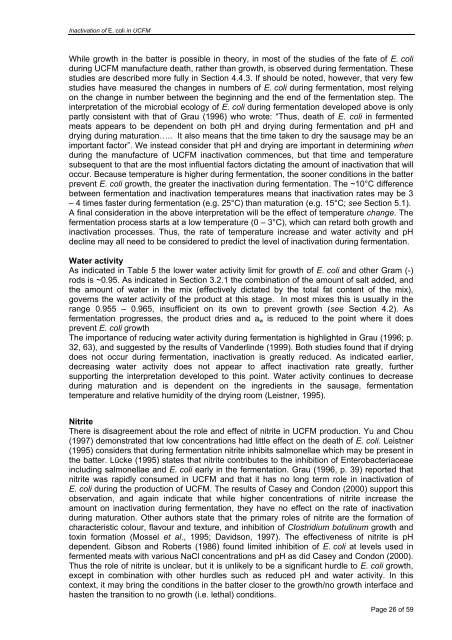Download "Predicting E. coli inactivation in uncooked comminuted ...
Download "Predicting E. coli inactivation in uncooked comminuted ...
Download "Predicting E. coli inactivation in uncooked comminuted ...
You also want an ePaper? Increase the reach of your titles
YUMPU automatically turns print PDFs into web optimized ePapers that Google loves.
Inactivation of E. <strong>coli</strong> <strong>in</strong> UCFMWhile growth <strong>in</strong> the batter is possible <strong>in</strong> theory, <strong>in</strong> most of the studies of the fate of E. <strong>coli</strong>dur<strong>in</strong>g UCFM manufacture death, rather than growth, is observed dur<strong>in</strong>g fermentation. Thesestudies are described more fully <strong>in</strong> Section 4.4.3. If should be noted, however, that very fewstudies have measured the changes <strong>in</strong> numbers of E. <strong>coli</strong> dur<strong>in</strong>g fermentation, most rely<strong>in</strong>gon the change <strong>in</strong> number between the beg<strong>in</strong>n<strong>in</strong>g and the end of the fermentation step. The<strong>in</strong>terpretation of the microbial ecology of E. <strong>coli</strong> dur<strong>in</strong>g fermentation developed above is onlypartly consistent with that of Grau (1996) who wrote: “Thus, death of E. <strong>coli</strong> <strong>in</strong> fermentedmeats appears to be dependent on both pH and dry<strong>in</strong>g dur<strong>in</strong>g fermentation and pH anddry<strong>in</strong>g dur<strong>in</strong>g maturation….. It also means that the time taken to dry the sausage may be animportant factor”. We <strong>in</strong>stead consider that pH and dry<strong>in</strong>g are important <strong>in</strong> determ<strong>in</strong><strong>in</strong>g whendur<strong>in</strong>g the manufacture of UCFM <strong><strong>in</strong>activation</strong> commences, but that time and temperaturesubsequent to that are the most <strong>in</strong>fluential factors dictat<strong>in</strong>g the amount of <strong><strong>in</strong>activation</strong> that willoccur. Because temperature is higher dur<strong>in</strong>g fermentation, the sooner conditions <strong>in</strong> the batterprevent E. <strong>coli</strong> growth, the greater the <strong><strong>in</strong>activation</strong> dur<strong>in</strong>g fermentation. The ~10°C differencebetween fermentation and <strong><strong>in</strong>activation</strong> temperatures means that <strong><strong>in</strong>activation</strong> rates may be 3– 4 times faster dur<strong>in</strong>g fermentation (e.g. 25°C) than maturation (e.g. 15°C; see Section 5.1).A f<strong>in</strong>al consideration <strong>in</strong> the above <strong>in</strong>terpretation will be the effect of temperature change. Thefermentation process starts at a low temperature (0 – 3°C), which can retard both growth and<strong><strong>in</strong>activation</strong> processes. Thus, the rate of temperature <strong>in</strong>crease and water activity and pHdecl<strong>in</strong>e may all need to be considered to predict the level of <strong><strong>in</strong>activation</strong> dur<strong>in</strong>g fermentation.Water activityAs <strong>in</strong>dicated <strong>in</strong> Table 5 the lower water activity limit for growth of E. <strong>coli</strong> and other Gram (-)rods is ~0.95. As <strong>in</strong>dicated <strong>in</strong> Section 3.2.1 the comb<strong>in</strong>ation of the amount of salt added, andthe amount of water <strong>in</strong> the mix (effectively dictated by the total fat content of the mix),governs the water activity of the product at this stage. In most mixes this is usually <strong>in</strong> therange 0.955 – 0.965, <strong>in</strong>sufficient on its own to prevent growth (see Section 4.2). Asfermentation progresses, the product dries and a w is reduced to the po<strong>in</strong>t where it doesprevent E. <strong>coli</strong> growthThe importance of reduc<strong>in</strong>g water activity dur<strong>in</strong>g fermentation is highlighted <strong>in</strong> Grau (1996; p.32, 63), and suggested by the results of Vanderl<strong>in</strong>de (1999). Both studies found that if dry<strong>in</strong>gdoes not occur dur<strong>in</strong>g fermentation, <strong><strong>in</strong>activation</strong> is greatly reduced. As <strong>in</strong>dicated earlier,decreas<strong>in</strong>g water activity does not appear to affect <strong><strong>in</strong>activation</strong> rate greatly, furthersupport<strong>in</strong>g the <strong>in</strong>terpretation developed to this po<strong>in</strong>t. Water activity cont<strong>in</strong>ues to decreasedur<strong>in</strong>g maturation and is dependent on the <strong>in</strong>gredients <strong>in</strong> the sausage, fermentationtemperature and relative humidity of the dry<strong>in</strong>g room (Leistner, 1995).NitriteThere is disagreement about the role and effect of nitrite <strong>in</strong> UCFM production. Yu and Chou(1997) demonstrated that low concentrations had little effect on the death of E. <strong>coli</strong>. Leistner(1995) considers that dur<strong>in</strong>g fermentation nitrite <strong>in</strong>hibits salmonellae which may be present <strong>in</strong>the batter. Lücke (1995) states that nitrite contributes to the <strong>in</strong>hibition of Enterobacteriaceae<strong>in</strong>clud<strong>in</strong>g salmonellae and E. <strong>coli</strong> early <strong>in</strong> the fermentation. Grau (1996, p. 39) reported thatnitrite was rapidly consumed <strong>in</strong> UCFM and that it has no long term role <strong>in</strong> <strong><strong>in</strong>activation</strong> ofE. <strong>coli</strong> dur<strong>in</strong>g the production of UCFM. The results of Casey and Condon (2000) support thisobservation, and aga<strong>in</strong> <strong>in</strong>dicate that while higher concentrations of nitrite <strong>in</strong>crease theamount on <strong><strong>in</strong>activation</strong> dur<strong>in</strong>g fermentation, they have no effect on the rate of <strong><strong>in</strong>activation</strong>dur<strong>in</strong>g maturation. Other authors state that the primary roles of nitrite are the formation ofcharacteristic colour, flavour and texture, and <strong>in</strong>hibition of Clostridium botul<strong>in</strong>um growth andtox<strong>in</strong> formation (Mossel et al., 1995; Davidson, 1997). The effectiveness of nitrite is pHdependent. Gibson and Roberts (1986) found limited <strong>in</strong>hibition of E. <strong>coli</strong> at levels used <strong>in</strong>fermented meats with various NaCl concentrations and pH as did Casey and Condon (2000).Thus the role of nitrite is unclear, but it is unlikely to be a significant hurdle to E. <strong>coli</strong> growth,except <strong>in</strong> comb<strong>in</strong>ation with other hurdles such as reduced pH and water activity. In thiscontext, it may br<strong>in</strong>g the conditions <strong>in</strong> the batter closer to the growth/no growth <strong>in</strong>terface andhasten the transition to no growth (i.e. lethal) conditions.Page 26 of 59


